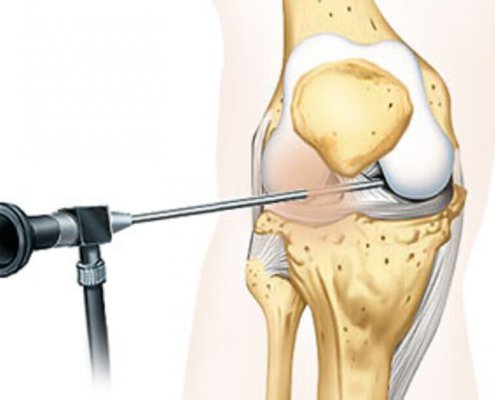Knee arthroscopy / Knee endoscopy
minimally invasive procedure
A knee arthroscopy is less stressful and less painful for the patient than a normal operation. The knee joint recovers more quickly and the process enables quicker recovery to full strength.
What is a knee arthroscopy (joint endoscopy)?
Arthroscopy is a buttonhole surgery, minimally invasive surgical procedure. As a rule, two 1cm skin incisions are made. A thin high-resolution camera is introduced through the first incision, to assess the joint in detail. The necessary intervention is carried out through the second incision with thin surgical instruments.
When is a knee arthroscopy useful?
Meniscal tear (meniscus rupture)
The meniscus is a shock absorber between the articular surfaces of the knee joint. It distributes the load evenly on the cartilage and stabilizes the joint. There is an inner and an outer meniscus. Its crescent-shaped structure consists of fiber cartilage.
A meniscus tear is a very common injury and mostly affects the posterior portion of the medial meniscus. The tear can occur acutely as part of trauma. Most cracks, however, arise as a result of a degenerative weakening of the tissue over a long period of time.
Patients develop sharp pain in the affected part of the joint. The meniscus can also become trapped between the joint surfaces, which leads to a sudden restriction of movement in the knee joint.
In most cases, the torn portion of the meniscus must be removed. If possible, the meniscus is sutured.
Plica mediopatellaris (mucosal fold)
If a fold of the mucous membrane, starting from the synovium, gets trapped between the joint surfaces of the kneecap and the load-bearing surface of the thigh, pain and cartilage damage can occur in the anterior part of the knee joint. This so-called plica syndrome occurs mainly when climbing stairs and when walking downhill. Patients often feel the kneecap “jumping”.
Therapeutically, the fold of mucous membrane is removed arthroscopically.
Circumscribed cartilage defect
A circumscribed cartilage defect is a strictly localized injury to the cartilage. In contrast to osteoarthritis of the knee, which affects the entire knee joint, the remaining structures are intact in the case of a circumscribed cartilage defect.
Microfracturing can be performed therapeutically. The bone marrow below the cartilage defect is drilled with a narrow awl. As a result, a blood clot rich in stem cells forms in the defect, from which a replacement cartilage is created.
Where is a knee arthroscopy performed?
In the Orthopedic Hospital Vienna Speising, knee arthroscopies can usually be performed on a outpatient basis (i.e. you will be discharged on the day of the operation).
Follow-up treatment after knee arthroscopy?
As a rule, after a knee arthroscopy, you can fully use the knee in a pain-free manner. Crutches are recommended for support during the first few days. Physiotherapy and exercise on the bicycle ergometer can begin after 2 weeks. Jogging is allowed after 6 weeks and stop-and-go sports after 3 months.
What complaints do you have?
After a detailed diagnosis, I will work with you to plan your therapy.
Make an appointment in my ordination right away:
T: 01 587 21 31 or online

